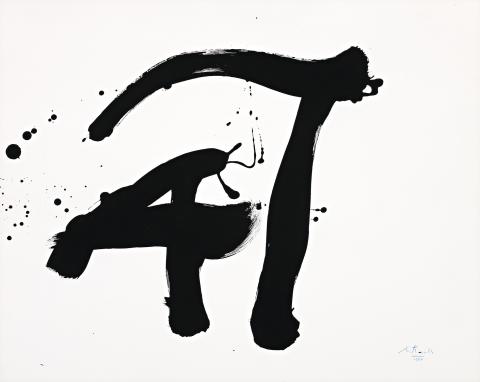UNTITLED, 1987
ROBERT MOTHERWELL
synthetic polymer paint on Strathmore paper
58.5 x 73.5 cm
signed and dated lower right: Motherwell / 1987
signed, dated and inscribed on label attached verso: R.Motherwell / “Untitled” 1987 / Acrylic [...]/
INV. #D87 – 3492
Dedalus Foundation, New York
Bernard Jacobson Gallery, London (label attached verso, cat. RM5098)
Annandale Galleries, Sydney
Private collection, Sydney
The Linear Image: American Master Works on Paper, Marisa del Re Gallery, New York, 25 April – 27 May 1989, cat. 24 (illus. in exhibition catalogue) (label attached verso, cat. CO2273)
Robert Motherwell, Important Paintings on Paper in association with Bernard Jacobson Gallery,
London, Annandale Galleries, Sydney, 27 July – 20 August 2005
Flam, J., Rogers, K., & Clifford, T., Robert Motherwell Paintings and Collages, A Catalogue Raisonné, 1941 – 1991: Volume Three, Collages and Paintings on Paper and Paperboard, Yale University Press, Connecticut, USA, cat. w691, p. 650 (illus.)
‘The emergence of abstract art is a sign that there are still men of feeling in the world. Men who know how to respect and follow their inner feelings, no matter how irrational or absurd they may first appear…’1
Arguably one of the most eloquent and intellectually accomplished artists of the twentieth century, Robert Motherwell remains universally esteemed for not only his groundbreaking legacy as the leading exponent of the Abstract Expressionist movement, but for the breadth and influence of his writing, editing and teaching which sought to both bridge and challenge the dual forces of American and European modernism. With their simple shapes, strong colour contrasts and dynamic balance between restrained and boldly gestural brushstrokes, his paintings, prints and collages do not simply expound formal tenets of art history, philosophy and contemporary art however. More profoundly perhaps, Motherwell’s vast oeuvre reflects a sincere and considered engagement with autobiographical content, contemporary social and political events, and the essential human conditions of life, death, oppression and revolution.
Born in Washington in 1915, Motherwell displayed a precocious talent for creative pursuits and at age 11, was awarded a scholarship to study at the Otis Art Institute, Los Angeles. From 1932 – 36, he embarked upon a Bachelor of Arts in Philosophy at Stanford University (where he developed a lifelong passion for the symbolist literature that would so inspire his art), and in 1940, moved to New York to undertake his PhD at Columbia University. A formative influence upon his artistic development, pre-eminent art historian Meyer Shapiro encouraged Motherwell to devote himself to painting rather than scholarship and accordingly, introduced the young artist to a group of exiled European surrealists living in New York at the time including Max Ernst, Marcel Duchamp, André Masson and Roberto Matta. Deeply impressed by the surrealist notion of ‘automatism’ – the accessing of material from the subconscious mind as part of the creative process – Motherwell subsequently embraced the principle as the foundation for the establishment of Abstract Expressionism (or ‘the New York School’), experimenting and exhibiting alongside artists such as Jackson Pollock, William Baziotes, Barnett Newman and Mark Rothko. In 1944, he held his first solo show at Peggy Guggenheim’s Art of this Century gallery; the same year, MoMA, New York became the first museum to acquire one of his works and he was also appointed editor of the extremely influential ‘Documents of Modern Art’ series.
Unlike many of his fellow Abstract Expressionists whose lives and success burned brightly but for far too short a time, Motherwell enjoyed a long and highly acclaimed career spanning almost five decades in which he continued to investigate and expand upon these seminal ideas through his painting, writing and lectures. With its stark black and white palette, Untitled 1987 dates from Motherwell’s final years, yet nevertheless betrays unmistakable stylistic affinities to his earlier signature series – Elegies to the Spanish Republic – comprising over 140 paintings in which he expresses nostalgia for the lost cause of the Spanish Civil War, lamenting the human tragedies of oppression and injustice. Unlike the solemn brutality of his Elegies however, the present work reveals an elegance and lyricism in the spontaneous abstract ‘splash’ – a gesture which not only evokes the Chinese and Japanese calligraphy that Motherwell admired and collected, but equally, echoes the linear forms of Spanish surrealist Joan Miro and the strident black and white compositions of American contemporary Franz Kline. Indeed, unifying the formal concerns of European modernism with the more spontaneous, emotionally expressive methods of the Abstract expressionist movement, the work encapsulates superbly Motherwell’s thesis that ‘…Every intelligent painter carries the whole culture of modern painting in his head. It is his real subject, of which everything he paints is both an homage and a critique, and everything he says is a gloss.’2
1. Motherwell, R., cited in ‘What Modern Art Means to Me’, Museum of Modern Art Bulletin, vol. 18, no. 3 (Spring 1951), pp. 12 – 13
2. Motherwell, R., 1951, cited in Anfam, D., Abstract Expressionism, Thames and Hudson, London, 1990, p. 22
VERONICA ANGELATOS
